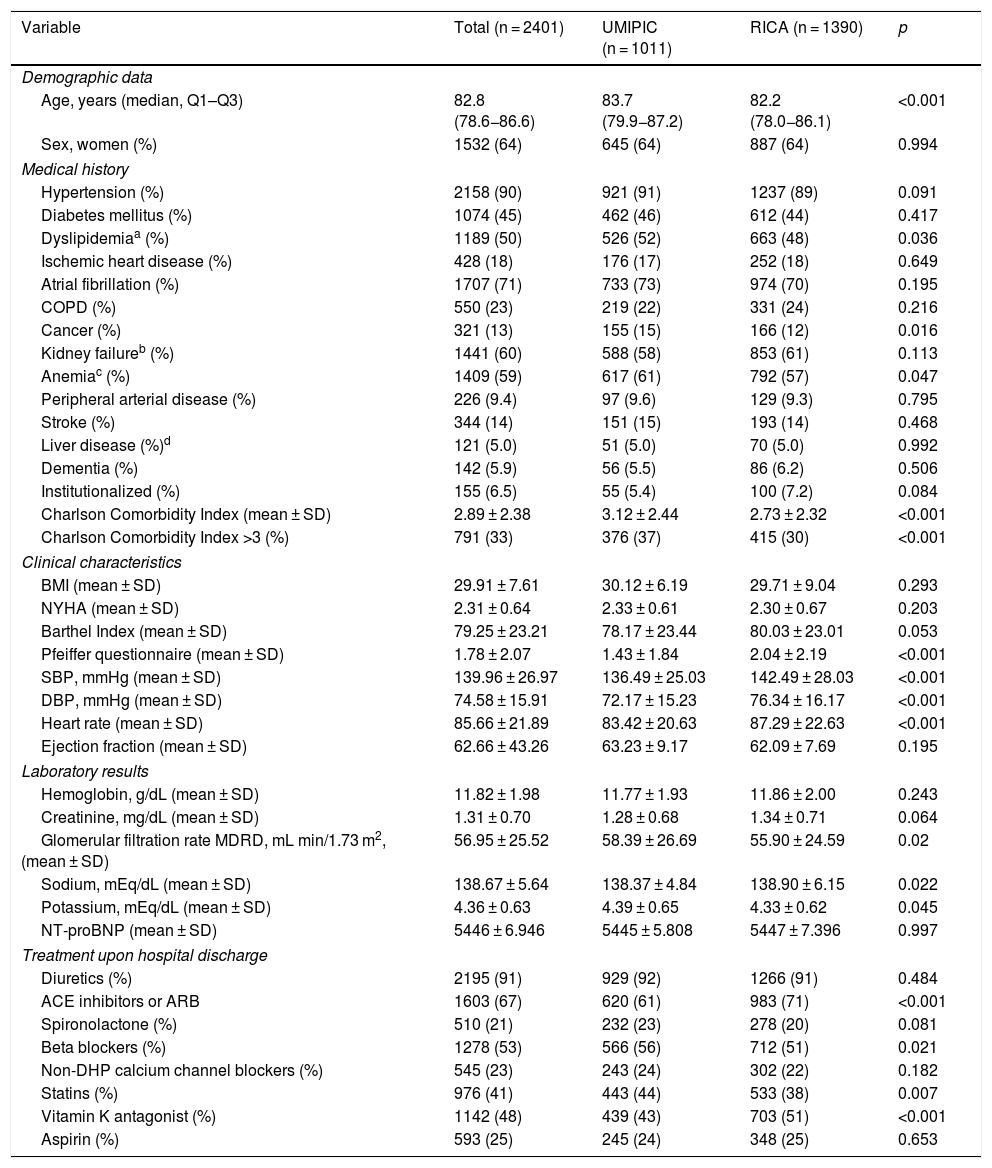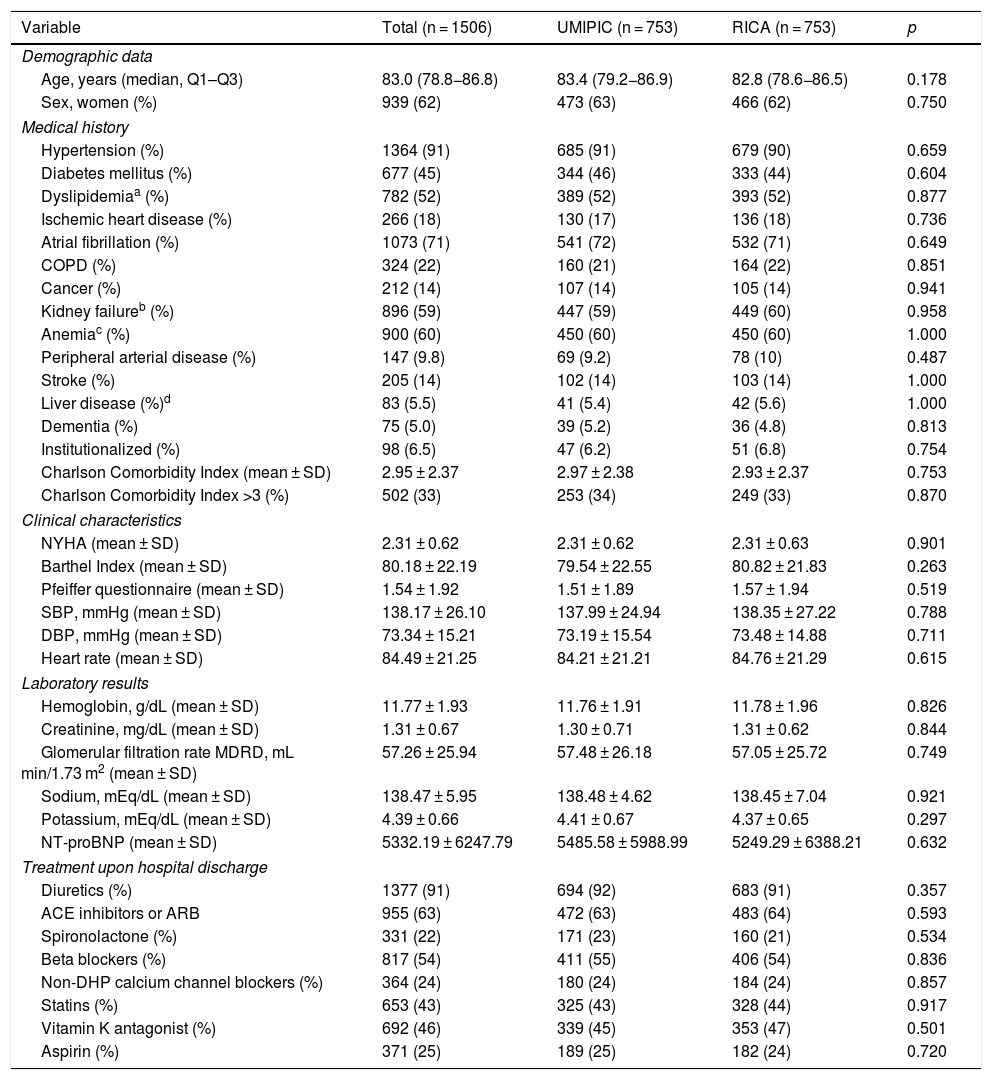Patients with heart failure (HF) and preserved ejection fraction (HFpEF), in contrast to those with reduced ejection fraction, are older, have more comorbidities, and are not candidates for effective therapeutic measures. Therefore, they are at high risk for hospital admission and mortality. This study evaluated the benefit of a comprehensive continuous care program (UMIPIC program) in patients with HFpEF.
MethodsWe prospectively analyzed data on 2401 patients with HFpEF attended to in internal medicine departments who form part of the RICA registry. They were divided into 2 groups: one was followed-up on in the UMIPIC program (UMIPIC group, n: 1011) and another received conventional care (RICA group, n: 1390). A total of 753 patients in each group were selected by propensity score matching and admissions and mortality were assessed during 12 months of follow-up after an episode of hospitalization due to HF.
ResultsCompared to the RICA group, the UMIPIC group had a lower rate of HF admissions (19.2% versus 36.5%, respectively; hazard ratio [HR] = 0.56; 95% confidence interval [CI]: 0.45–0.68; p < 0.001) and mortality (12.6% versus 28%, respectively; HR = 0.40; 95% CI: 0.31−0.51; p < 0.001). There were no differences in hospitalizations for non-HF causes.
ConclusionsImplementation of the UMIPIC program, which is based on comprehensive continuous care, for patients with HFpEF and a high degree of comorbidity reduces both admissions and mortality in the first year of follow-up.
Los pacientes con insuficiencia cardíaca (IC) y fracción de eyección preservada (ICFEp), a diferencia de aquellos con fracción de eyección reducida, son más ancianos, presentan más comorbilidades y no son candidatos a medidas terapéuticas eficaces. Por todo ello presentan un riesgo elevado de ingreso hospitalario y mortalidad. En este estudio se evaluó el beneficio de un modelo asistencial, caracterizado por una atención integral y continuada (programa UMIPIC) en pacientes con ICFEp.
MétodosSe analizaron prospectivamente los datos de 2.401 pacientes con ICFEp atendidos en servicios de medicina interna, procedentes del registro RICA. Se dividieron en 2 grupos, uno en seguimiento en el programa UMIPIC (grupo UMIPIC, n: 1.011) y otro atendido de forma convencional (grupo RICA, n: 1.390). Se seleccionaron por emparejamiento (propensity score matching) 753 pacientes en cada grupo y se evaluaron los ingresos y la mortalidad durante 12 meses de seguimiento, tras un episodio de hospitalización por IC.
ResultadosEl grupo UMIPIC, con respecto al RICA, en la cohorte emparejada, tuvo una menor tasa de ingresos por IC (19,2% frente a 36,5% respectivamente; hazard ratio [HR] = 0,56; intervalo de confianza del 95% [IC 95%]: 0,45−0,68; p < 0,001) y de mortalidad (12,6% frente a 28%, respectivamente; HR = 0,40; IC 95%: 0,31−0,51; p < 0,001). No se observaron diferencias en cuanto a ingresos por causas distintas a la IC.
ConclusionesLa implementación del programa asistencial UMIPIC a pacientes con ICFEp y elevada comorbilidad, basado en una atención integral y continuada, reduce tanto los ingresos como la mortalidad al año de seguimiento.
Article
Diríjase desde aquí a la web de la >>>FESEMI<<< e inicie sesión mediante el formulario que se encuentra en la barra superior, pulsando sobre el candado.

Una vez autentificado, en la misma web de FESEMI, en el menú superior, elija la opción deseada.

>>>FESEMI<<<










